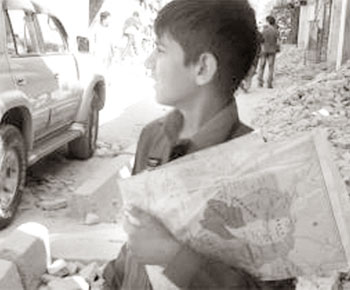Kabul street children struggle to survive
In crowded downtown Kabul, nine-year-old Ahmed looks like any other
energetic salesman hawking plastic bags for 10 cents a piece, darting in
and out of snarled traffic to chase after pedestrians. Except the child
peering out under a woollen hat, striding around in a blue jacket and
jeans is actually Khatera - a girl sent onto the streets by her father
to earn desperately needed money.
Only by disguising herself as a boy can she survive the competitive
market of child workers and score a sale. Girls get teased and harassed
in the male-dominated country with few employment opportunities for
women.
“My dear daughter just sell your plastic bags, don’t fight, you are a
girl anyway. The boys will beat you up. Just do your business and come
back,” advises Khatera’s father, helping her into her jacket.
Charity workers
|

Child worker |
The United Nations estimates there are 50,000 street children in the
Afghan capital alone. Among them are those who cannot afford an
education or those who are the only breadwinners for fatherless or
unemployed families.
Charity workers put the number at 60,000, saying the return of
refugees, insecurity and drought have pushed more children onto the
streets in the 10 years since US-led troops drove the Taliban from
power.
“The number of street children is increasing,” said Mohammad Yousif,
director of the charity Aschiana that works with street children in five
of Afghanistan’s 34 provinces.
“In 2003, there were around 38,000 street children in Kabul alone but
now it has increased to around 60,000,” he said.
“There are different reasons. The mass influx of refugees from
Pakistan and Iran, drought in some parts of the country and insecurity
has forced many families to leave their hometowns.
“As a result, the burden of supporting the family falls on the
shoulders of these poor children,” said Yousif.
Only bread-winner
With her brothers still too young, Khatera’s family depends on her.
She earns less than $ 2 a day, often the only means of support for a
family now expecting a new child.
“My father used to sell shoes, but he lost all his money on that. He
cannot find any work now,” she says.
“I am the only bread-winner in my family. If I don’t disguise myself
as a boy I cannot work on the streets, because I’ll get harassed and
scolded.”
Plying the capital’s streets has become a competitive business for
children, who have mastered every trick in the book for extracting
maximum cash.
They scavenge for rubbish, sell plastic bags, repair bicycles, labour
for shoe-makers or ask for alms in return for waving unwelcome wafts of
aromatic smoke designed to ward off the devil at passers-by.
Job-seekers
Every day, six-year-old Bilal buys eggs then drops them on a dirty
footpath, sitting miserably next to the mess to attract sympathy. “I’ve
lost 100 Afghanis ($ 2). I have to beg now otherwise my family will be
left without food tonight,” he cries over his carton of smashed eggs.
On another street corner, nine-year-old Rahim pushes a handcart past
honking cars, looking for a profitable spot to sell his pile of bananas.
Around six million people live in Kabul, a city swollen by
job-seekers who have poured in from the provinces and by refugees who
flocked home from Iran and Pakistan after the fall of the Taliban in
late 2001.
Yet despite billions of dollars in Western development aid, the
United Nations says half Afghanistan’s estimated population of 30
million live below the poverty line in what remains one of the world’s
poorest countries.
There has been huge progress in the number of Afghan children in
compulsory, full-time education since the US-led invasion.
According to the education ministry, seven million students were
registered at government schools this year compared to one million in
2002.
But Afghanistan has one of the lowest literacy rates in the world,
with about 50 percent of men and just 20 percent of women able to read
and write.
Working year-round, under burning sun or in freezing snow, Khatera is
one of those who may slip through the cracks - her education limited to
early morning classes to learn to read the Koran at a nearby mosque.
“Today I earned 40 Afghanis. How much have you earned?” she asks her
friend. “I have 60 Afghanis,” her friend, a boy of same age, replies.
AFP |



